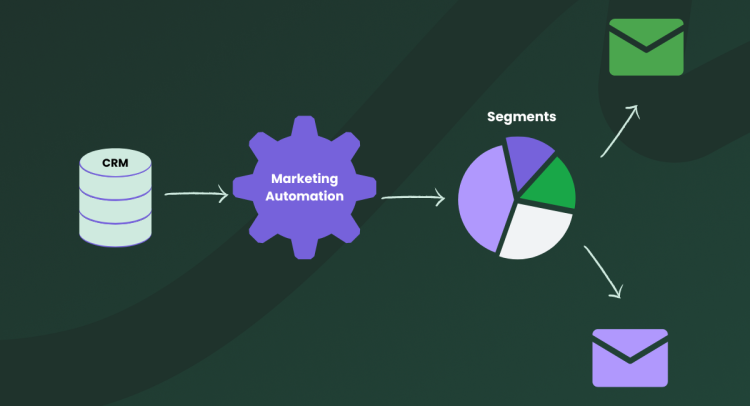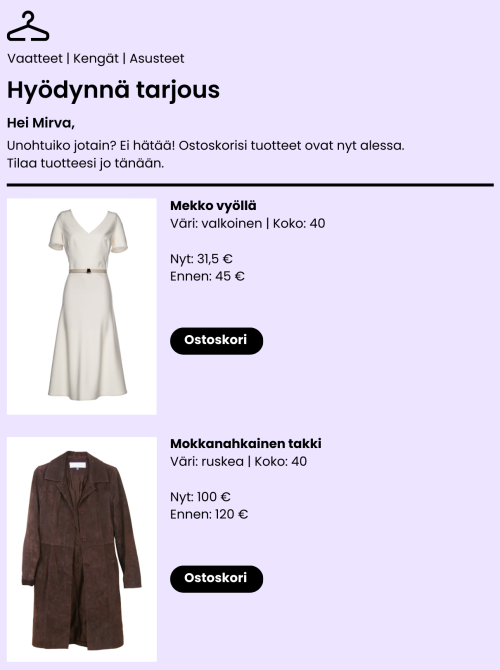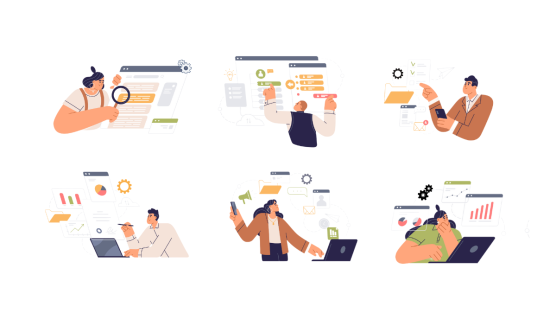Companies are constantly collecting huge amounts of information about their customers, but they don't always use it effectively in their marketing activities. Often, this information remains scattered between different systems and people - without being available in one place. In practice, companies' customer insight is often broken down into small pieces of data: customer service knows one piece, marketing another, and sales perhaps a third. This leaves data lying around in systems without the potential to be exploited.
So how can existing customer data be effectively harnessed for marketing? In this fourth and final part of our marketing automation in practice series, we will look at concrete examples of marketing automation where data from different systems is put into practice through automation.
CRM and marketing automation
CRM (Customer Relationship Management) stores and organizes all your customer information. When you integrate CRM with your marketing automation system, you harness customer relationship management data into your marketing efforts. In this case, integration with your marketing automation system can also help sales and marketing work together more effectively.
So how do CRM and automation work together? Here are some practical examples of marketing automation that use data from CRM in automated messages:
- Automate targeted newsletters to different segments based on customer stage or activity
- Send an automated offer or set up an appointment for customers who have not purchased in a while
- Send an invitation to your organization's event to potential customers who have already had one meeting
- Send an automatic renewal reminder well before the end of the contract period
- Send an automatic welcome campaign to customers with whom you have just signed a contract
- Automatically collect feedback from terminated or former customers.

An example of marketing automation in action is how the system retrieves the necessary data from the CRM system and automates the sending of letters according to the set segments.
eCommerce and marketing automation
Businesses' online stores contain a significant amount of information about shoppers, such as their customer data and information about their behavior. This data provides a great opportunity for personalized content and targeted marketing. By combining eCommerce customer data with marketing automation, you can boost your upselling and cross-selling efforts.
Here are a few marketing automation examples of how to use data from your online store:
- Segment customers based on purchases and send targeted newsletters to different groups
- Send an automated newsletter to buyers of a specific product, recommending products that match that product
- Send a reminder to the buyer of a regularly subscribed product that it's time to renew soon
- Send the purchaser of a product an automatic information pack on the best ways to use the product
- Send a reminder for an abandoned cart, and offer to help with any problems
- Send the customer information about the progress of the order and delivery

An example of marketing automation in action is how the system retrieves the necessary data from the CRM system and automates the sending of letters according to the set segments.
Booking system and marketing automation
Reservation systems contain a wide range of information and most of them include data on customer loyalty, dates, availability and prices of the product or service booked, and other details. These provide excellent opportunities for creative use of automation. Whether it's a hotel booking, a dental appointment, or a car inspection, there are plenty of opportunities for further cross-selling and customer development.
Here are a few marketing automation examples for leveraging data from a booking system:
- Offer a better rate to someone who booked a hotel through the international reservation service if they book directly through the hotel's system next time
- Send an automated drip campaign to the person who booked the holiday, informing them of the upcoming destination and promoting additional services for a fee
- Send a booking reminder and offer personalized service to avoid last-minute cancellations
- Send an offer for a dental check-up to someone who had one a year ago
- Offer an upgrade to a better cabin class for someone who booked a cruise and encourage them to make restaurant reservations in advance
- Automatically ask for feedback after the event and promote your next event
- Send information about local events if your system includes location information.

The automation will retrieve the necessary information from your booking system to send you feedback surveys and promote your next events.
In addition, the integration of the reservation system with automation provides a helping hand for your employees. A concrete example of the time saved by marketing automation is how time management becomes more efficient as work steps are reduced through integration. Systems that work together send information about cancellations and transfers, without individual employees having to devote their own resources to this.
In practice, interoperable systems help in this way: if a customer decides to cancel or transfer a reservation, the automation system sends a notification to the staff. Staff can respond quickly to the customer and offer possible solutions to the situation, such as a new booking date or a refund. This way, the information is not missed and staff can react quickly, which helps to improve customer satisfaction.
Consider these integrations as well
In addition to the ones already mentioned, here are a few more examples of marketing automation integrations that allow you to leverage the data you already have:
- Website integration: allows you to leverage data generated from website tracking, such as time spent on the site and interests. Using this data, you can develop better campaigns and marketing messages, and produce more personalized content for your site using data collected through automation to create personalized content sections for individual visitors.
- Synchronization of campaign data: today, campaign creation is spread across multiple systems. By integrating the different systems into the automation system, information about the different actions of customers starts to accumulate in the customer profiles of the automation system. These actions can be aggregated into broader sets and used to create segments. For example, someone who subscribed to a guide on the website and read a blog post on the topic "X" can be added to an interest list on that topic and also automatically added to the topic's newsletter list in the email marketing tool.
- Integration with other tools: discuss with your automation partner the systems you have in place and their capabilities. For example, most event management systems, chatbots, membership information systems, and checkout systems can be integrated with automation. A competent partner can provide and implement the most relevant and efficient solutions for your business.
Existing customer data is the starting point for automation
Making full use of existing customer data and keeping it up-to-date is a great starting point for the implementation of marketing automation and personalized communications. A versatile customer database enables the creation of precise segments based on different criteria, such as the separation of those who have made a one-off purchase, but who have clicked and opened promotional emails on a particular product area, into a specific customer segment.
However, it is worth noting that harnessing existing data and creating the necessary integrations to implement automation is a collaborative project, where the importance of an expert partner is paramount. While joint compression may seem like a lot of work upfront, it is worth remembering that when existing data, integrations, and automation systems work together, they quickly start to bear fruit. When multiple systems are integrated into an automation tool, the overall communications picture and customer groups become more easily distinguishable.
Need a marketing automation tool and an expert partner?
With our native LianaAutomation tool, you can quickly get to the implementation level of automation and experience the benefits of automation in practice. We help you harness existing customer data, and thanks to our open interface, we create the necessary new integrations tailored to your needs.
Ask about marketing automation!



